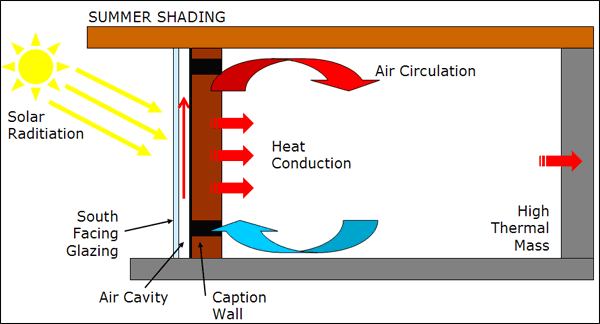Trombe Wall
A Trombe wall simply put is a very thick, south-facing wall (or North facing wall if in the Southern Hemisphere), which is painted black and made of a material that absorbs a lot of heat. A pane of glass or plastic glazing, installed a few inches in front of the wall, helps hold in the heat. The wall heats up slowly during the day. Then as it cools gradually during the night, it gives off its heat inside the building.
Trombe walls are a great ‘passive’ (as in no mechanical parts) way of providing heat to a room or space. They are often easily built from readily available materials and very reliable. An extra benefit is that the heat is radiated in the infra red, which is more penetrating and pleasant than the traditional convective forced air heating systems.
How does the Trombe Wall work?
With reference to the diagram on the right. The simplest form of Trombe wall consists of a glass pane held against a wall with an air space behind it. Connecting this air space with the inner room are two vents, one at the top and one at the bottom of the air space. During the day the Sun heats first the air in this space, then the solid wall behind. Once the air is heated it rises and enters into the room, giving it additional heat. Also the rising air pulls in cooler air from the room below to then be heated. The real trick with this though, is that for sometime after the sun goes down the now hot wall will still keep heating air and exchanging that heat into the room.
Though once the wall is cold you need to stop the cold of the outside interacting with the inside, so a one way flap is used on the bottom vent to stop the cold coming back into the room and creating a cooling cycle with the room.
It consists of a dark colored wall of high thermal mass facing the sun, with glazing spaced in front to leave a small air space. The glazing traps solar radiation like a small greenhouse. An attached sunspace is essentially a Trombe wall where the air space is so big it is habitable.
Trombe walls are a very useful passive heating system. They require little or no effort to operate, and are ideal for spaces where silence and privacy are desirable. Sunspaces are equally simple and silent, and can allow views. Rooms heated by a Trombe wall or sunspace often feel more comfortable than those heated by forced-air systems, even at lower air temperatures, because of the radiantly warm surface of the wall.
If you’ve invested in solar power for your property then you’re probably sitting back and enjoying the benefits! Unfortunately solar panels do require maintenance, something you may not have realized until you were researching; many people aren’t aware that solar panels to require specific care. One of the easiest and least expensive ways to maintain the health of your solar panels is through cleaning. Simple cleaning procedures will ensure that your solar panels are in the best shape possible.
A successful Trombe wall or attached sunspace optimizes heat gain and minimizes heat loss during cold times, and avoids excess heat gain in hot times.
The characteristics of a Solar Wall as compared to a direct gain window:
- Its efficiency in collecting solar heat is not as high as a direct gain window of the same size.
- Night heat losses are less than for a direct gain windows.
- Very simple — no fans, no ducts, no controllers.
- Does not provide daylighting or views as a direct gain window would — this can be an advantage or disadvantage.
- The inside surface of the wall can be used to some extent, but should not be covered with anything that reduces heat transfer from the wall to the living space.
- Depending on the current wall construction, it may be easier to retrofit a solar wall than to retrofit a direct gain window, since no wall structural members are cut.
Advantages
- Comfortable Heat: Radiates in the infra red, which is more penetrating and pleasant than traditional convective forced air heating systems.
- Passive: No moving parts and essentially no maintenance.
- Simple Construction: Relatively easy to incorporate into building structure as an internal or external wall. Materials (masonry, concrete) are relatively inexpensive.
- Effective: Can reduce heating bills by large amounts.






